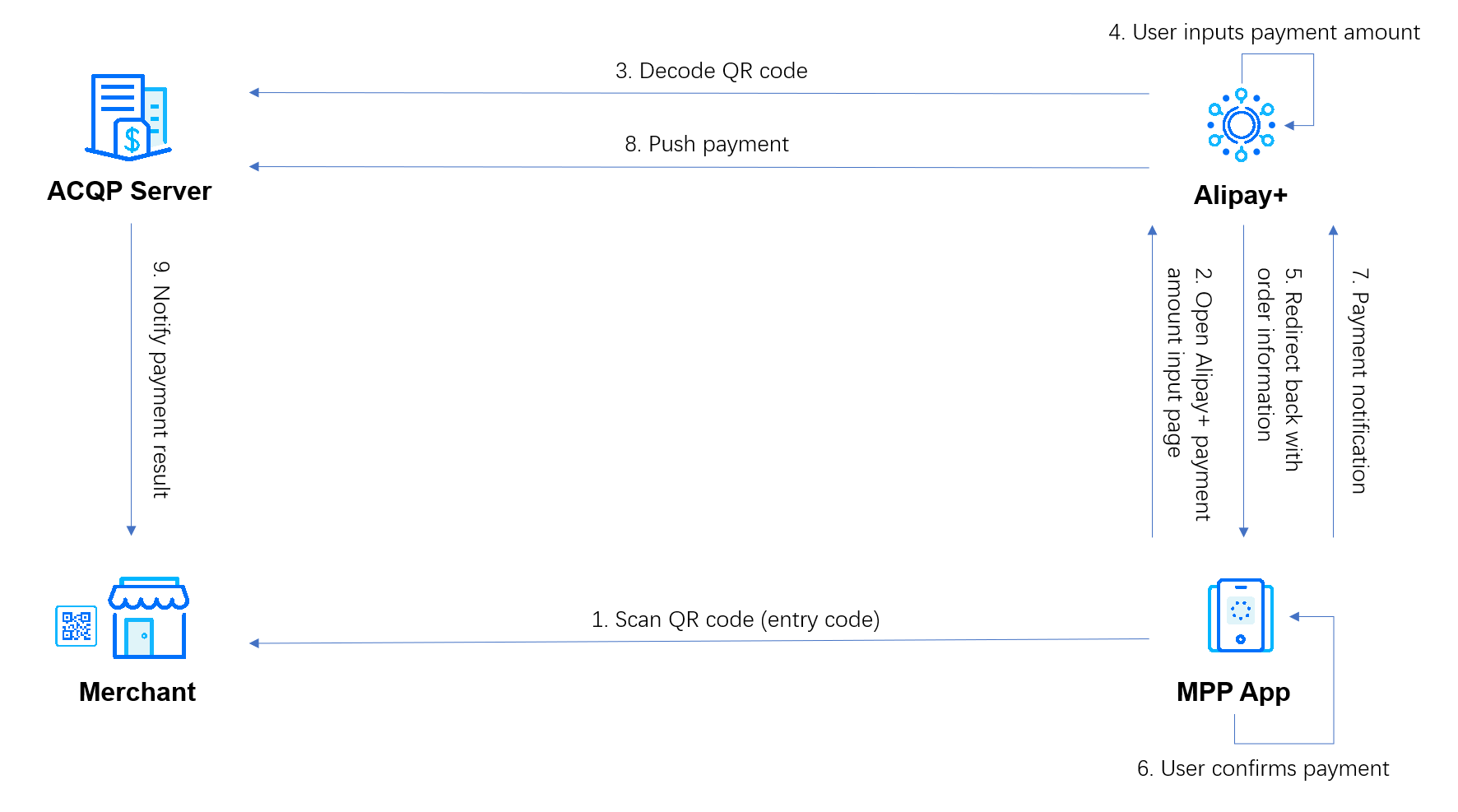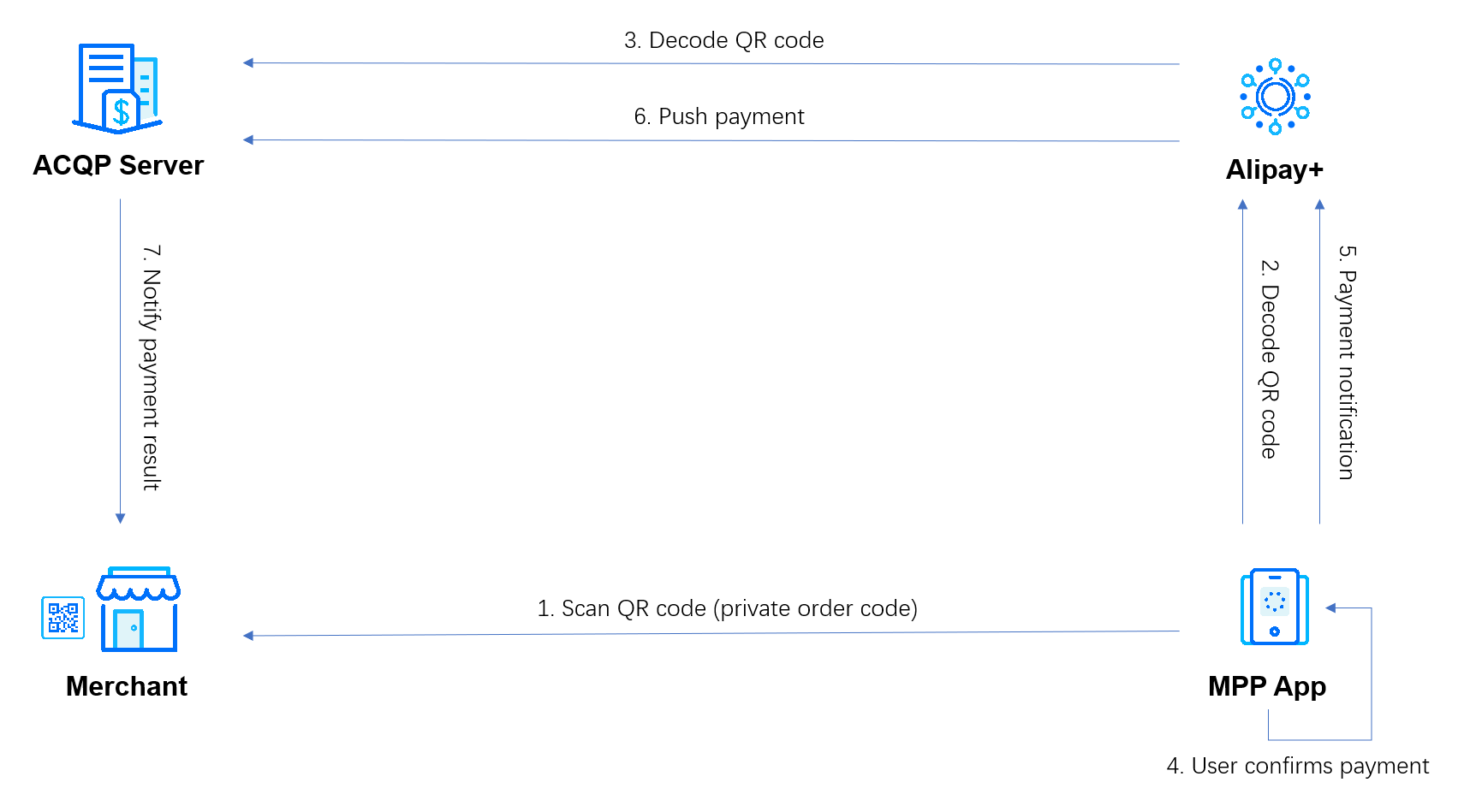Merchant-presented Mode Payment (Push Mode)
This topic introduces Merchant-presented Mode Payment (Push Mode).
With Merchant-presented Mode Payment, a user can scan the QR code presented by the merchant to complete the payment.
Alipay+ supports the following two types of QR codes:
- Entry code: a static QR code that is issued by the ACQP to represent the merchant.
- Private order code: a dynamic QR code that is issued by the ACQP to represent the order.
The user experience differs between entry code and private order code.
- When an entry code is scanned, the user is firstly redirected to the Alipay+ payment amount input page to enter the payment amount and then redirected to the wallet payment confirmation page.
- When a private order code is scanned, the user is directly redirected to the wallet payment confirmation page to confirm the payment.
The ACQP can choose which QR code type to use based on the merchant business scenarios and the technical capabilities.
For more information about the user experience, product functionalities, and the workflow of each QR code type, see the following sections.
Basic concepts
Terms (Abbreviations) | Definition |
Acquiring Service Provider (ACQP) | An Acquiring Partner participating in Alipay+ Core or other acquirer cooperating with a member of Ant Group to enable payments. |
Alipay+ | Alipay+ solution is a collaborative effort along with all partners to provide more open, digitalized, and inclusive financial services to worldwide users and merchants. |
Merchant-presented Mode Payment | A payment scenario that the user scans the merchant-presented code with a digital device, such as a mobile phone, to initiate the payment. |
Mobile Payment Provider (MPP) | A Mobile Payment Partner participating in Alipay+ Core or other user- or issuer-facing payment service provider cooperating with a member of Ant Group to enable payments. |
QR Code | Quick Response Code as defined in ISO/IEC 18004. |
Push Mode | Push Mode, or Push Payments Mode, is a type of Merchant-presented Mode Payment workflow in which the MPP makes the payment and the ACQP accepts it. |
Pull Mode | Pull Mode, or Pull Payments Mode, is a type of Merchant-presented Mode Payment workflow in which the ACQP requests the MPP to pay. |
Entry code
With Merchant-presented Mode Payment Entry Code, the ACQP issues a static QR code to the merchant, who displays the QR code in the merchant store. After scanning the QR code, the user is prompted to enter the order amount and then redirected to the payment confirmation page on the wallet side. The user then confirms the order information and enters the password to complete the payment.
User experience
The following figure illustrates the Merchant-presented Mode Payment user experience where the code is an entry code:

Figure 1. Merchant-presented Mode Payment Entry Code user experience
The Merchant-presented Mode Payment Entry Code workflow contains the following steps:
- The user scans the entry code presented by the merchant.
- The user is redirected to the Alipay+ payment amount input page to enter the payment amount.
- The user is redirected to the wallet payment page to complete the payment.
- The payment result is displayed on the wallet page.
More information
- To arouse the user interest and enhance the user brand awareness, the ACQP needs to well display the Alipay+ brand information. For more information, see Brand display guidelines for in-store payment in the Alipay+ Brand guideline.
- To ensure a smooth and unified user experience, the ACQP also needs to ensure outputs such as the QR code are standard. For more information, see Standard output checklist.
Product functionalities
Alipay+ Merchant-presented Mode Payment Entry Code offers the following main features:
Payment
Accept a payment: Alipay+ sends a decoding request to the ACQP to obtain the merchant information from the entry code, with which Alipay+ and the user generate an order for the MPP to pay. After the MPP processes the payment, Alipay+ pushes the payment to the ACQP, requesting to accept the payment on the ACQP side.
Return the payment result
- Payment inquiry: Alipay+ inquires the ACQP about the status of the payment after pushing the payment to the ACQP.
- Payment notification: When the payment reaches a final status (success or failure), the ACQP can actively notify the result to Alipay+.
Refund
Refund: The ACQP can apply for a refund of successful orders on behalf of its merchants. Both full and partial refunds are supported.
Business operations
- One-stop settlement: Alipay+ provides a unified funds clearing and settlement service for ACQPs. Instead of mutual settlement, ACQPs only need to settle with Alipay+, which greatly simplifies the funds processing and improves the settlement efficiency.
- Merchant registration: The ACQP can register merchant information or update an existing registration timely.
How it works
The following figure illustrates the Merchant-presented Mode Payment workflow when the QR code is an entry code:

Figure 2. Merchant-presented Mode Payment Entry Code workflow
The entry code workflow contains the following steps:
- The user scans the QR code (entry code).
- The MPP app opens the Alipay+ payment amount input page and sends the code value to Alipay+.
- Alipay+ requests the ACQP server to decode the QR code and obtain the merchant information.
- The user inputs the payment amount to generate the order.
- The user is redirected back to the MPP app with order information.
- The user confirms the payment in the MPP app.
- The MPP app notifies Alipay+ of the payment.
- Alipay+ pushes the payment to the ACQP server.
- The ACQP notifies the merchant of the payment result.
Note: Unless otherwise required (such as regulation), the ACQP does not need to know the specific MPP. The ACQP can inform merchants that no change is needed for new MPPs.
Get started
To get started with the Alipay+ integration, see Get started with Alipay+ integration.
For more information about how to integrate the Merchant-presented Mode Payment Entry Code functionalities, see Integration overview for Merchant-presented Mode Payment Entry Code.
Private order code
With Merchant-presented Mode Payment Private Order Code, the ACQP issues a dynamic QR code to the merchant. The merchant presents the QR code to the user, who scans the QR code to be redirected to the payment confirmation page on the wallet side. The user then confirms the order information and enters the password to complete the payment.
User experience
The following figure illustrates Merchant-presented Mode Payment user experience where the code is a private order code:

Figure 5. Merchant-presented Mode Payment Private Order Code user experience
The Merchant-presented Mode Payment Private Order Code workflow contains the following steps:
- The user chooses goods, then the merchant presents an order code.
- The user scans the order code.
- The user confirms to pay.
- The payment result is displayed on the result page.
More information
- To arouse the user interest and enhance the user brand awareness, the ACQP needs to well display the Alipay+ brand information. For more information, see Brand display guidelines for in-store payment in the Alipay+ Brand guideline.
- To ensure a smooth and unified user experience, the ACQP also needs to ensure outputs such as the QR code are standard. For more information, see Standard output checklist.
Product functionalities
Alipay+ Merchant-presented Mode Payment Private Order Code offers the following main features:
Payment
Accept a payment: Alipay+ sends a decoding request to the ACQP to obtain the order information from the private order code. After the MPP processes the payment, Alipay+ pushes the payment to the ACQP, requesting to accept the payment on the ACQP side.
Return the payment result
- Payment inquiry: Alipay+ inquires the ACQP about the status of the payment after pushing the payment to the ACQP.
- Payment notification: When the payment reaches a final status (success or failure), the ACQP can actively notify the result to Alipay+.
Refund
Refund: The ACQP can apply for a refund of successful orders on behalf of its merchants. Both full and partial refunds are supported.
Business operations
- One-stop settlement: Alipay+ provides a unified funds clearing and settlement service for ACQPs. Instead of mutual settlement, ACQPs only need to settle with Alipay+, which greatly simplifies the funds processing and improves the settlement efficiency.
- Merchant registration: The ACQP can register merchant information or update an existing registration timely.
How it works
The following figure illustrates the Merchant-presented Mode Payment workflow when the QR code is a private order code:

Figure 6. Merchant-presented Mode Payment Private Order Code workflow
The private order code workflow contains the following steps:
- The user scans the QR code (private order code).
- The MPP app sends the code value to Alipay+ to decode the QR code.
- Alipay+ requests the ACQP server to decode the QR code and obtain the order information.
- After the MPP app obtains the order information, the user confirms the payment in the MPP app.
- The MPP app notifies Alipay+ of the payment.
- Alipay+ pushes the payment to the ACQP server.
- The ACQP notifies the merchant of the payment result.
Note: Unless otherwise required (such as regulation), the ACQP does not need to know the specific MPP. The ACQP can inform merchants that no change is needed for new MPPs.
Get started
To get started with the Alipay+ integration, see Get started with Alipay+ integration.
For more information about how to integrate the Merchant-presented Mode Payment Private Order Code functionalities, see Integration overview for Merchant-presented Mode Payment Private Order Code.
